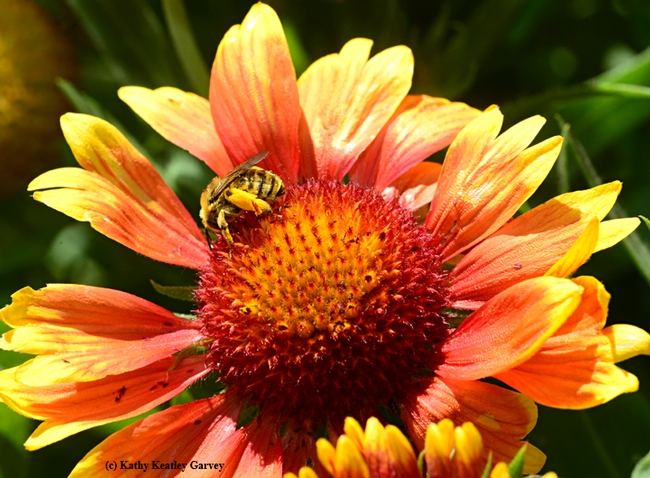As we near the end of celebrating National Pollinator Week, June 16-22, look around and see all the insects foraging on reddish-orange flowers. And occasionally, you might see a reddish-orange insect like the showy Gulf Fritillary butterfly.
Orange, a color commonly associated with autumn, Halloween and Thanksgiving, is also a color that brightens many of our seasons and draws attention to special occasions, including Pollinator Week.
The reddish-orange Gulf Fritillary (Agraulis vanillae) spreads its wings on a purple coneflower (Echinacea purpurea). A honey bee (Apis mellifera) and a sunflower bee (Melissodes agilis) forage on a blanket flower (Gallardia). Another bee, the leafcutting bee, Megachile fidelis, and a green bottle fly take a liking to a Mexican sunflower (Tithonia rotundifolia).
Pollinators come in all sizes, shapes, colors and species, from bees, birds, butterflies, bats and beetles, to flies.
Many folks throughout the country observe National Pollinator Week once a year, but some organizations, such as the Xerces Society for Invertebrate Conservation, protect our pollinators and promote pollinator conservation every day.
On their website:
"Pollinators are essential to our environment. The ecological service they provide is necessary for the reproduction of over 85 percent of the world's flowering plants, including more than two-thirds of the world's crop species. The United States alone grows more than one hundred crops that either need or benefit from pollinators, and the economic value of these native pollinators is estimated at $3 billion per year in the U.S. Beyond agriculture, pollinators are keystone species in most terrestrial ecosystems. Fruits and seeds derived from insect pollination are a major part of the diet of approximately 25 percent of all birds, and of mammals ranging from red-backed voles to grizzly bears. In many places, the essential service of pollination is at risk from habitat loss, pesticide use, and introduced disease."
Indeed, pollinators pack a punch.
Attached Images:

Gulf Fritillary (Agraulis vanillae) spreads its wings on a purple coneflower (Echinacea purpurea). (Photo by Kathy Keatley Garvey)

A sunflower bee (Melissodes agilis) forages on a blanket flower (Gallardia). (Photo by Kathy Keatley Garvey)

A green bottle fly rests on a Mexican sunflower (Tithonia rotundifolia). (Photo by Kathy Keatley Garvey)

Honey bee (Apis mellifera) on a blanket flower (Gallardia). (Photo by Kathy Keatley Garvey)

A leafcutting bee, Megachile fidelis, on a Mexican sunflower (Tithonia rotundifolia). (Photo by Kathy Keatley Garvey)